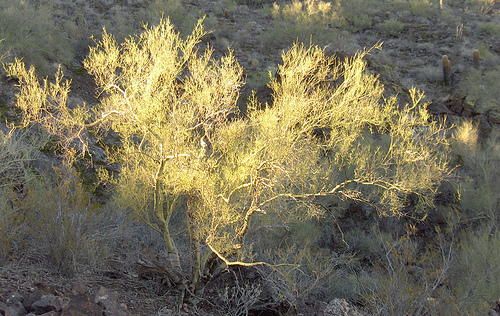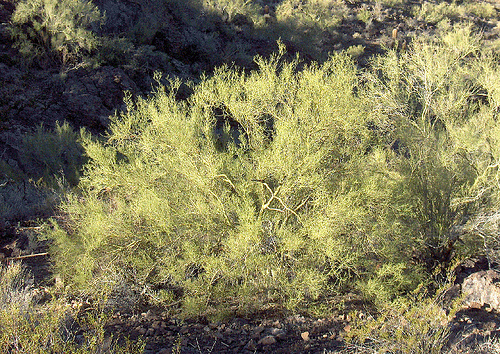Palo Verde ‘Desert Museum’

Question from Jane:
We live in Southern California in Sunset Zone 23 and are doing some re-landscaping in our back yard. We have already decided to put in some paperbark melaleucas for a grove-like effect. On the other side of the yard I would like to plant a Palo Verde tree, Desert Museum type. Do you think the colors of those two trees which we will be looking down on from above, as well as from street level, will be attractive together? I’m thinking of bark and leaf color especially. Thanks so much for your help.

Photo by homeredwardprice 
Answer from Pat:
I see no conflict between the color and texture of palo verde ‘Desert Museum’ (Cercidium ‘Desert Museum’), which has smooth green bark and yellow flowers, and paperbark tree (Melaleuca quinquenervia), which has shaggy light brown to white, peeling bark and yellowish-white flowers. I think it adds interest to one’s garden when one chooses a variety of colors and textures to contrast with one another. There are a few trees I personally would not choose to plant next to each other, such as a bright orange African tulip tree next to a bright purple crape myrtle, since they bloom at the same time, but other gardeners might find this spectacular clash of colors fun and stimulating. I have seen orange bougainvilleas flanked with purple ones and the sight was memorable. In the case of the two trees you have chosen, each has a soft and harmonious color scheme, not bright or flagrant. The textures also add pleasant variety instead of shock value.
Cercidium ‘Desert Museum’ is a hybrid form of palo verde, a cross between Parkinsonia aculeata (Mexican palo verde), little-leaf palo verde (Cercidium microphyllum), and blue palo verde (C. floridum). Due to its hybrid nature it combines many of the best traits of all three of its parents, it blooms longer, and is less messy. I should warn you, however, that all palo verde trees are desert plants and thus they are best adapted to Sunset Zones 8-14 and 18-20. This may not make it one of the best choices for your climate zone (23). I think it will be all right, nonetheless, but before making a final decision could you find another tree that would give you a desert look but be better adapted to your climate? Have you considered desert willow (Chilopsis linearis)? It is adapted to zone 23 and is equally drought-resistant as palo verde. It comes in many named varieties with flowers ranging from deep purple to wine, lavender, white and pale yellow, two-tone burgundy, and pink. Read the descriptions on page 268 of the latest edition of Sunset Western Garden Book. Another idea is redbud (Cercis). There are many good ones to choose from with water needs varying from moderate to regular. Native or Western redbud (Cercis occidentalis) is very drought resistant, can give a spectacular display in spring and has interesting bark in winter.
Photo by homeredwardprice 


I was not around when the landscaper planted my dream tree, the Desert Museum Palo Verde. It is a 15 gallon tree and was planted with a berm. I unfortunately did not water the tree enough during the first 10 days and there is lot of leaf drop and yellowing of the new baby branches. I am now watering daily -slow water for an hour about 5-7 gallons with a slow hose. I have heard that you do not want to overwater, but I am really worried that I already underwatered.
Your main problem is that your landscaper failed to warn you not to plant the tree in late spring or early summer. Also he or she should have given you instructions how to care for the new landscaping. All natives are best planted in November and desert landscapes should be installed in autumn so they can become established during the cooler months of the year. I wish I could help you but unfortunately there is little that I can suggest or do to aid you, only to send you good thoughts that the tree might survive. My advice is to stop watering now and phone your landscaper. Report the problem to him or her and ask for detailed instructions and help.